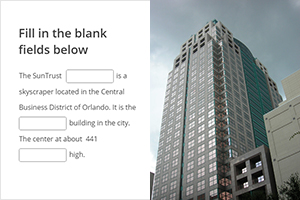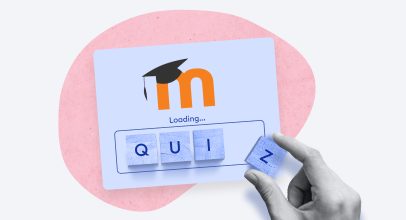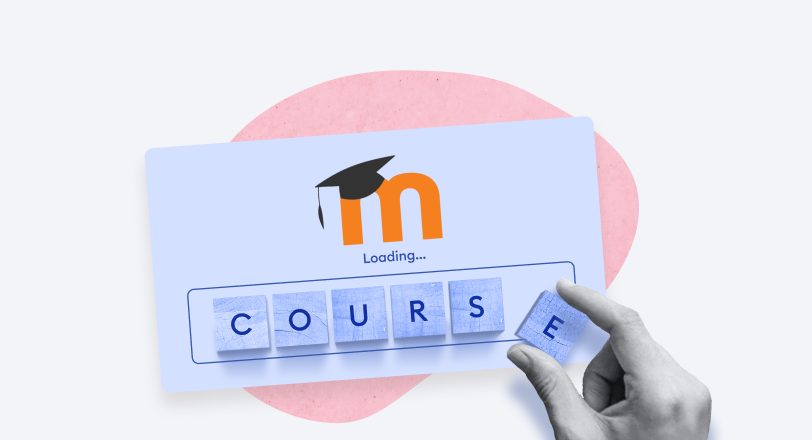8 Tips for Writing Good Fill-in-the-Blank Questions in E-Learning Courses

Assessment tools offer tremendous advantages to both the instructor and the learner, and are thus an important part of instructional design. Despite their importance, developing quality assessments is not as simple or straightforward as one might think. A great deal of care needs to go into developing quality assessments to ensure that the question actually assesses the target knowledge rather than something else, such as test-taking skills. Additionally, the instructor needs to remain open to revising questions based on learner performance—if all students get a single question wrong or right, both are considered poor questions and both should be removed from the test because they’re actually not testing anything. Thus, instructors need to pay attention to student performance on each individual testing item to ensure each one is doing its job of actually assessing the target knowledge.
Why are fill-in-the-blank questions so effective?
Common question types include multiple choice, true-false, matching, fill-in-the-blank, short answer, and essay. Multiple choice, true-false, and matching questions can all be assessed immediately by computer and offer immediate results. Fill-in-the-blank, short answer, and essay questions all require assessment by hand—they are a lot more work to assess than the other question types. This is definitely something to keep in mind when designing assessment instruments—how much time does the instructor want to spend checking and evaluating responses? If that answer is zero, then the former question types should comprise the entirety of the test. If only a few learners are involved in the course, it may not be terrible to evaluate some questions by hand. But, if the course will be disseminated to thousands of learners, the instructor probably does not want even a single question that requires hand grading.
Fill-in-the-blank-type questions differ from the other question types in that they demand recall skills. Multiple-choice, true-false, and matching all rely on recognition, since all response possibilities are given and the learner must merely identify the correct one. But fill-in-the-blank-type questions require producing a concept and therefore, test learners’ knowledge of individual terms and concepts at a deeper level than recognition question types. Short answer and essay-type questions differ as well, delving into deeper cognitive processes such as analysis and synthesis. Fill-in-the-blank-type questions are really the only ones that require recall, making them a useful tool to assess acquisition of knowledge.
The main thing to keep in mind when developing any type of assessment item is to ensure that it tests what it’s intended to test. That seems simple, but as instructional designers we tend to bring with us a variety of assumptions and holes in our perception—by definition, these operate below our awareness. Extreme care and attention must be given to ensure each test item targets the intended concept and only the intended concept, and that its presentation is crystal clear. The question should not be part of a complex guessing game or mind-reading exercise. Questions need to be clear and precise, and acutely targeted.
So you’ve decided you want your learners to recall and produce target items, which means fill-in-the-blank-type questions. Here are some things to keep in mind when developing these types of questions.
1. Keep them simple and clear
The question sentence must be written so that the idea you intend to elicit is clear. It should not be confounded by a bunch of complex concepts. Remember your goal is to ensure your learners can produce the term, not simplify the complex and magically come up with the right answer in the process or to have the learner try to figure out for herself what kind of information you’re looking for. Keep it simple.
2. Ensure there is only one correct answer for the blank
Since we create these questions with a particular term in mind, it’s easy to overlook the fact that similar concepts might also fit properly into the blank. You’ll know if this has occurred based on the responses you get. It’s important to fairly evaluate the responses you receive for their accuracy within the blank. Sometimes an answer you intended as wrong is actually correct given the sentence. So, sometimes this pinpointing to only one possibility takes a couple of rounds of refining the question.
3. Use the blank judiciously
Ensure that the sentence makes sense without the term in the blank, and that the intended term is easily derived from the sentence you do provide. Otherwise, it will likely be confusing, leaving learners to frustration and guesswork, which does not accurately test their knowledge.
4. Keep answers brief
Responses to these kinds of questions are usually a single word or couple of words representing a single concept. Thus, be sure to construct the question so that only a single item is left out.
5. Limit the number of blanks per question
Each question should have one or maximum two blanks, not more. The more blanks you put into the question, the less sense the sentence has and the more difficult (i.e. confusing) it is to answer.
6. Don’t give clues to the correct response in the question
This is always a challenge in developing good questions, but an important point to keep in mind. In fill-in-the-blank-type questions, one easy thing is to make the length of the blanks uniform. It’s too easy for learners to view the length of the blank and assume the target term fits there, so they search their internal information banks for a term of a certain length. This is not what you want, as it does not really test knowledge. Avoid this cognitive trick by making your blanks the same length.
7. Review it carefully
When you’re starting to create these kinds of questions, it’s a good idea to have someone familiar with the content take the assessment before publishing it. This provides a test for your questions. If you’re getting unintended responses that still fit with the sentence, revisions are necessary. For this reason, these kinds of questions are not the easiest to write—there is a lot of inherent gray area, so take great care to ensure the questions and their intended responses are clearly black and white.
8. Revise, tighten, clarify
Even for seasoned test creators, it’s not easy to write really clear sentences that point to only one possible correct response. The greater the variety of responses you get to a question, the less clear the question is and the more it needs revising.
The two most important things to keep in mind when developing test questions are: 1) ensure the question tests the target knowledge and only the target knowledge; and 2) be open to revising and tossing out poor questions. With these guidelines, you are well on your way to creating high-quality fill-in-the-blank-type questions.
Create interactive quizzes for learning, knowledge checks, and skill practice










